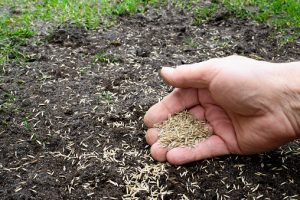The lawn is the centrepiece of a large percentage of UK gardens. There’s not much more pleasing to the eye, than a healthy, well-manicured, lush green, patch of grass, especially if you’ve bought the right lawnmower and learned how to make stripes on the lawn.
Now, if you’re looking out of your window and seeing a patchy, semi-bald area where your perfect lawn should be, there’s no need to worry. This article is designed to teach you how to plant grass seed so that it grows into a grassy wonder, the likes of which you normally see on tennis courts or football pitches.
Planting grass seed has some advantages over buying and laying turf down. The main one is cost: it’s a lot cheaper to plant grass seed.
Another is the fact that you get to choose from a wider variety of grass types when sowing seeds than when buying turf, and this can make it easier to find a particular type that is best suited to your garden soil.
There is also much less of a hurry when planting grass seed as opposed to laying turf. If you didn’t know, turf should ideally be laid within 24 hours of delivery or it can start to deteriorate. On the other hand, you can store your seeds easily and choose the optimum time to plant them, or even take longer to prepare the soil and get the growing conditions just right.
How to prepare your seedbed for planting grass seed
A perfect lawn starts with the correct preparation of the planting area. The better job you do of this, the more success with germination and less chances of problems occurring in the future.
The first thing to do is to check what type of soil that you have. If you’re lucky you’ll have beautiful, nutrient rich soil, but it is often the case that this isn’t so, and you could have clay or sandy soil instead.

If this is so, don’t worry, it’s not the end of the world and you’ll just need to lay down some topsoil to rectify the situation.
Once you’ve got your soil sorted, you should scarify it and remove any weeds from the soil. You could also use a fertiliser/weed killer combination product to make extra sure those nasty weeds are gone. Also get rid of any large stones.
Overly compacted soil can be bad for drainage which is bad for your lawn, so grab an aerator and go over the seedbed with it. This usually needs doing with clay soil.
Rake your seedbed flat and level, so that you end up with a lawn with the same qualities. If you’re noticing big bumps or dips in the area, you should use top soil and rake again until everything is as level as possible.
Pick from the best grass seed options this summer
Choosing a type of grass seed
Best lawn feed this summer
If you speak to someone at your garden centre, or an online grass seed supplier, they should be able to point you in the right direction for the best grass seed. Just be honest and accurate when you tell them about the conditions that your grass seed will be growing in, so they can help you choose the right type. Alternatively take a look at our resources highlighted.
For instance, there are types of seed that will do better in drought (or if you forget to water them), while others will need less sunlight which would be good if your garden gets a lot of shade.
When to plant grass seed in the UK
The window for planting grass seed in the U.K is actually quite wide and spans from mid-march to the end of September.
However, we all know how our weather likes to throw us surprises so you still need to keep an eye on the weather forecast when you’re thinking of planting grass seed.

If the temperatures are going to drop below 10 degrees due to an unexpected patch of cold weather, the seeds might have problems germinating. Likewise, if there is a spell of hot and dry conditions, you’re going to have to step up the watering schedule.
It’s my advice that you plant your grass seed at the end of the window, in September. At this time, the soil is still warm enough, and you don’t have to worry about overly hot temperatures damaging your seedlings.
There will also be more natural moisture around during this time so you don’t have to water the area like a crazy person like you’d have to in the midst of summer.
How To Turf A Lawn
6 Best Lawn Feed Spreaders Reviewed
A guide to the 5 best lawn aerators reviewed in the UK
Lawn scarifiers rated
How to plant grass seed
Once your soil has been prepped, the weeds and stones removed, and everything is nice and level with soft, broken up soil, you can start planting your grass seed.
The best, and most accurate way to do this, is to grab some canes or other kind of easily seen sticks, plastic poles, etc. and a tape measure. Use the tape measure and canes to mark out the seedbed into sections that are a square metre each.

Next, weigh out your grass seed using kitchen scales into the amounts recommended on the packaging, and keep them in separate containers. You can use anything for this such as cups, dishes, etc. it’s just so you have the same amount going into each square metre section of the seedbed.
With your seed weighed out, all that you need to do now is sow it, but for the best results don’t just throw it anywhere. Instead, sow half of the seed in one direction inside one of the square metres of soil, then the other half in the opposite direction.
Finally, lightly rake the area so the seed is covered and water
Best lawn mower
And that’s all there is to it. You now know when and how to plant grass seed in the UK.
it should go without saying that you should avoid treading on the seedbed until at least 6 months after sowing the seeds.
If you planted the grass seed in September to early October, you should feed the lawn the following spring to promote growth and produce great results.
